
The Letrouitiaceae are a family of lichen-forming fungi belonging to the order Teloschistales. The family, which has a tropical and subtropical distribution, contains the single genus Letrouitia, which contains about 15 species. The family and the genus, both circumscribed in 1982 by André Bellemère and Josef Hafellner, are named in honour of Marie-Agnès Letrouit-Galinou.
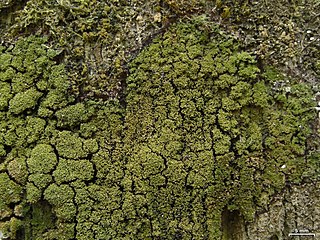
Phyllopsora is a genus of lichenized fungi in the family Ramalinaceae. It was circumscribed by Swiss botanist Johannes Müller Argoviensis in 1894.
Ioplaca is a genus of crustose lichens in the family Teloschistaceae. The genus was circumscribed in 1977 by Czech lichenologist Josef Poelt with Ioplaca sphalera assigned as the type species.

Lobothallia is a genus of lichens in the family Megasporaceae. Species in the genus have foliose thalli that become crustose areolate in the center with age, and grow on calcareous to siliceous rocks. The crustose part of the body may keep its lower cortex, though not always. Dark brown to black apothecia may be sunken into the surface of the thallus, as indicated in the common name puffed sunken disk lichen. Members grow to 3–5 cm (1.2–2.0 in) or more radiating lobes (placodioid). The photobiont is green alga from the genus Trebouxia. The genus is represented in Eurasia, Asia, North Africa, Central America, western North America, and Australia.
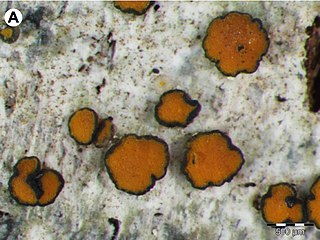
Ikaeria is a genus of two species of crustose lichens in the family Teloschistaceae. Both species grow on twig bark of shrubs and trees. It was circumscribed in 2017 by lichenologists Sergey Kondratyuk, Dalip Kumar Upreti, and Jae-Seoun Hur, with Ikaeria aurantiellina assigned as the type species. This lichen was previously placed in the genus Caloplaca, but molecular phylogenetic analysis showed that it belonged in a lineage that was genetically distinct from that genus. Ikaeria serusiauxii was added to the genus in 2020.

Ikaeria serusiauxii is a species of crustose lichen in the family Teloschistaceae. It is found in the Madeira Archipelago and Canary Islands (Macaronesia), as well as in coastal regions of Algarve and Estremadura in mainland Portugal, where it grows on twigs and branches of trees and shrubs. It was described as a new species in 2020 by lichenologist Harrie Sipman. The type specimen was found on Porto Santo Island, on the lower slopes of Pico do Facho, at an altitude of about 350 m (1,150 ft). Here it was growing on fallen pine trees. The specific epithet honours Belgian lichenologist Emmanuël Sérusiaux, "who contributed significantly to the exploration of the lichen diversity of Macaronesia".

Squamulea is a genus of lichen-forming fungi in the family Teloschistaceae. It has 15 species. The genus was circumscribed in 2013 by Ulf Arup, Ulrik Søchting, and Patrik Frödén, with Squamulea subsoluta assigned as the type species. Five species were included in the original account of the genus. The genus name alludes to the squamulose growth form of most of its species. Squamulea has a worldwide distribution; when the genus was originally created, the centre of distribution was thought to be in southwestern North America.
Sirenophila is a genus of crustose lichens in the subfamily Teloschistoideae of the family Teloschistaceae. It has four species with an Australasian distribution.
Caloplaca kedrovopadensis is a little-known species of crustose lichen in the family Teloschistaceae. It is only found in the Kedrovaya Pad Nature Reserve in the Russian Far East, and on the Jiri Mountain of South Korea. The lichen has been recorded growing on rocks and on bark.
Lecanora ussuriensis is a species of saxicolous (rock-dwelling) lichen in the family Lecanoraceae. It is found in single localities in the Primorsky Krai region of the Russian Far East, as well as in Japan.
Alfred Mycolayovych Oxner was a Ukrainian botanist and lichenologist. His research covered various areas: floristics, taxonomy, phylogenetics, phytogeography, and phytosociology. Oxner founded the National Lichenological Herbarium of Ukraine.
Neobrownliella is a genus of crustose lichens in the subfamily Teloschistoideae of the family Teloschistaceae. It has five species. The genus was circumscribed in 2015 by lichenologists Sergey Kondratyuk, Jack Elix, Ingvar Kärnefelt, and Arne Thell, with Neobrownliella brownlieae assigned as the type species. It is a segregate of the large genus Caloplaca. Characteristics of Neobrownliella include a thallus that is continuous or areolate, the presence of anthraquinones as lichen products, a cortical layer with a palisade paraplectenchyma, and the lack of a thick palisade cortical layer on the underside of the thalline exciple. Two species were included in the original circumscription of the genus; an additional three species were added in 2020.
Bryostigma epiphyscium is a species of lichenicolous fungus in the order Arthoniales. Formerly classified in the genera Arthonia and Conida, it was transferred to the genus Bryostigma in 2020.

Tomnashia is a genus of lichen-forming fungi in the family Teloschistaceae. It has four species of saxicolous (rock-dwelling), crustose lichens that occur in southwestern North America.
Teuvoahtiana is a genus of lichen-forming fungi in the family Teloschistaceae. It contains three species of saxicolous (rock-dwelling), crustose lichens, all of which occur in South America.
Elixjohnia is a genus of lichen-forming fungi in the family Teloschistaceae. It has four species of saxicolous (rock-dwelling), crustose lichens that occur in Australasia.
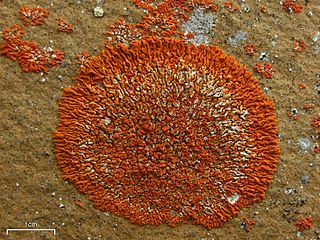
Rusavskia is a genus of lichen-forming fungi in the family Teloschistaceae. It has 12 species. It is a member of the subfamily Xanthorioideae. The thallus of Rusavskia is characterized by its foliose (leaf-like) structure with distinct and typically narrow lobes that curve outwards.
Rusavskia indica is a species of both corticolous (bark-dwelling) and saxicolous (rock-dwelling) lichen in the family Teloschistaceae. Found in India, it was formally described as a new species in 2017 by lichenologists Sergey Kondratyuk and Dalip Kumar Upreti. The type specimens were collected in Jammu-Kashmir.
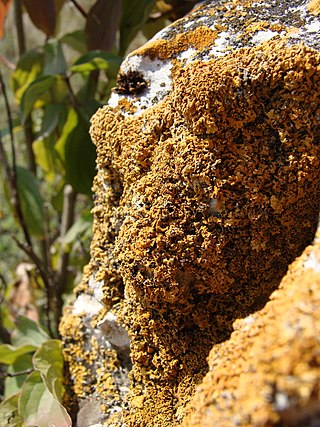
Zeroviella is a genus of lichen-forming fungi in the subfamily Xanthorioideae of the family Teloschistaceae. It has eight saxicolous (rock-dwelling) species. Zeroviella was segregated from Rusavskia, a closely related genus, in 2015.
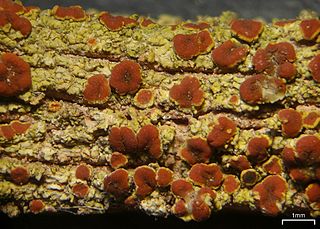
Opeltia is a genus of lichen-forming fungi in the family Teloschistaceae. It has four species of corticolous (bark-dwelling), crustose lichens.








